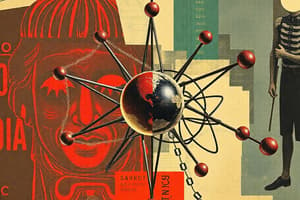Podcast
Questions and Answers
If an atom absorbs energy, what happens to its electrons?
If an atom absorbs energy, what happens to its electrons?
- They are ejected from the atom, leading to ionization.
- They move to a higher energy level, resulting in an excited state. (correct)
- They remain in the same energy level but spin faster.
- They move to a lower energy level, stabilizing the atom.
Which of the following best describes the difference between carbon-12 and carbon-14?
Which of the following best describes the difference between carbon-12 and carbon-14?
- Carbon-12 has more electrons than carbon-14.
- Carbon-14 has more protons than carbon-12.
- Carbon-12 and carbon-14 have the same number of neutrons.
- Carbon-14 has more neutrons than carbon-12. (correct)
What type of bond is formed when electrons are transferred from one atom to another?
What type of bond is formed when electrons are transferred from one atom to another?
- Nonpolar covalent bond
- Ionic bond (correct)
- Hydrogen bond
- Polar covalent bond
In a water molecule, oxygen has a slight negative charge and hydrogen has a slight positive charge. What type of bond holds a water molecule together?
In a water molecule, oxygen has a slight negative charge and hydrogen has a slight positive charge. What type of bond holds a water molecule together?
What property of water allows insects to walk on its surface without sinking?
What property of water allows insects to walk on its surface without sinking?
How does water's high heat of vaporization contribute to cooling the body?
How does water's high heat of vaporization contribute to cooling the body?
Which of the following pH values indicates the strongest acid?
Which of the following pH values indicates the strongest acid?
What is the primary function of buffers in biological systems?
What is the primary function of buffers in biological systems?
Which of the following elements is a fundamental component of all organic compounds?
Which of the following elements is a fundamental component of all organic compounds?
What is the primary function of carbohydrates within a living organism?
What is the primary function of carbohydrates within a living organism?
How many water molecules are removed during the formation of a disaccharide from two monosaccharides?
How many water molecules are removed during the formation of a disaccharide from two monosaccharides?
Which polysaccharide is the primary structural component of plant cell walls?
Which polysaccharide is the primary structural component of plant cell walls?
What distinguishes saturated fats from unsaturated fats at the molecular level?
What distinguishes saturated fats from unsaturated fats at the molecular level?
What type of lipid is a major component of cell membranes?
What type of lipid is a major component of cell membranes?
What type of bond links amino acids in a protein?
What type of bond links amino acids in a protein?
Flashcards
Neutral Atom
Neutral Atom
An atom maintains a neutral charge when the number of protons equals the number of electrons.
Isotopes
Isotopes
Atoms of an element that differ in neutron number.
Mass number
Mass number
The number of protons plus neutrons in an atom.
Covalent bond
Covalent bond
Signup and view all the flashcards
Polar Covalent Bond
Polar Covalent Bond
Signup and view all the flashcards
Polar-Polar Attraction
Polar-Polar Attraction
Signup and view all the flashcards
Van der Waals Forces
Van der Waals Forces
Signup and view all the flashcards
Specific heat
Specific heat
Signup and view all the flashcards
Water as the Universal Solvent
Water as the Universal Solvent
Signup and view all the flashcards
pH
pH
Signup and view all the flashcards
Organic compounds
Organic compounds
Signup and view all the flashcards
Carbohydrates
Carbohydrates
Signup and view all the flashcards
Starch
Starch
Signup and view all the flashcards
Simple lipids
Simple lipids
Signup and view all the flashcards
Proteins
Proteins
Signup and view all the flashcards
Study Notes
Basic Chemistry - Atomic Structure
- Atoms consist of protons, neutrons, and electrons.
- An atom in its elemental state has a neutral charge due to the number of protons equaling the number of electrons.
- Electron configuration determines how an atom will react with other elements.
- Electrons in the lowest available energy level are in the ground state.
- An atom that absorbs energy has electrons that move to a higher energy level and the atom is said to be excited.
- Isotopes are atoms of the same element with varying numbers of neutrons but the same number of electrons.
- Carbon-12 has 6 neutrons, while carbon-14 has 8 neutrons.
- Radioisotopes are radioactive isotopes used to diagnose and treat diseases and to measure the age of fossils.
Bonding
- A bond forms when two atoms attract electrons, releasing energy and requiring energy to break.
Ionic Bond
- Electrons are transferred between atoms.
- An atom that gains an electron becomes an anion (negative charge).
- An atom that loses an electron becomes a cation (positive charge).
Covalent Bond
- Atoms share electrons.
- The resulting structure is molecule.
- A single covalent bond involves two atoms sharing one pair of electrons.
- A double covalent bond involves two atoms sharing two pairs of electrons.
- A triple covalent bond involves two atoms sharing three pairs of electrons.
- Two types include polar and nonpolar covalent bonds.
Nonpolar Covalent Bond
- Electrons are shared equally between identical atoms.
- Examples: H₂(H-H) and O₂(O=O).
Polar Covalent Bond
- Electrons are shared unequally between unlike atoms.
- Examples: CO (C=O) and H₂O (H-O-H).
Intermolecular Attraction
- Molecules attract each other in three types.
Polar-Polar Attraction
- Occurs when molecules are either polar (unbalanced) or non-polar (balanced).
- Strong attractions exist between polar molecules.
Hydrogen Bond
- Found between water molecules.
- It attaches DNA strands together.
- Involved in the secondary protein structure.
Non-polar Molecules
- The weakest attractions (van der Waals forces) exist between non-polar molecules.
- The phosphodiester bond is a covalent linkage between a phosphate group of one nucleotide and the 3' carbon of the deoxyribose sugar of an adjacent nucleotide, forming the sugar-phosphate backbone of DNA.
Hydrophilic and Hydrophobic
- Hydrophilic substances love water.
- Hydrophobic substances hate water.
- Polar substances dissolve in water.
- Non-polar substances do not dissolve in water.
Characteristics of Water
- Water is asymmetrical, very polar, and exhibits strong intermolecular attractions and hydrogen bonds.
- High specific heat means it takes a lot of heat to increase temperature of 1 gram of water by 1 degree Celsius.
- Oceans absorb a lot of heat and resist changes in temperature.
- Evaporation of sweat cools the body.
- High adhesion properties help water flow up from plant roots to leaves, important for plant survival.
- Water is a universal solvent.
- It dissolves all polar and ionic molecules.
- Water has strong cohesion tension, helping molecules stick together.
- Facilitates water movement up tall trees without energy expenditure, referred to as transpiration-pull cohesion tension.
- Results in surface tension, allowing insects to walk on water.
- Ice is less dense than water, so it floats.
pH
- Measurement of acidity and alkalinity of a solution.
- Negative logarithm of the hydrogen ion concentration.
- Internal pH of living cells is close to 7.
- Biological systems use buffers to regulate pH by absorbing or donating hydrogen ions.
- Bicarbonate ion (HCO3) is the most important buffer in human blood.
- Acidity is inversely proportional to pH level.
- Acidity is directly proportional to hydrogen ion concentration.
Organic Compounds
- Contain carbon.
- Carbon is the most abundant element in the body.
- There are four classes: carbohydrates, lipids, proteins, and nucleic acids.
Carbohydrates
- Consist only of carbon, hydrogen, and oxygen.
- Provide quick energy.
- 1 gram releases 4 calories.
- Three classes: monosaccharides, disaccharides, and polysaccharides.
Monosaccharides
- Chemical formula C₆H₁₂O₆.
- Examples: glucose, galactose, and fructose.
Disaccharides
- Chemical formula C₁₂H₂₂O₁₁.
- Consist of two monosaccharides joined by dehydration synthesis.
- Glucose + Glucose → Maltose + water.
- Glucose + Galactose → Lactose + water.
- Glucose + Fructose → Sucrose + water.
- Hydrolysis breaks down compounds.
Polysaccharides
- Many monosaccharides linked by dehydration synthesis.
- Four Important Polysaccharides:
- Cellulose makes up plant cell walls.
- Starch is the way plants store carbohydrates.
- Chitin makes up the exoskeleton in arthropods and cell walls in mushrooms.
- Glycogen is the way animals store starch.
Lipids
- Are classified according to the chemical structure.
- Simple lipids: oils, fats, and waxes.
- Complex lipids: phospholipids
- Lipid derivatives: cholesterol, and some hormones (steroids)
Simple Lipids
- Diverse class including fats, oils, and waxes.
- Made up of 1 glycerol and 3 fatty acids.
- Glycerol is an alcohol, and fatty acids are hydrocarbon chains with a carboxyl group at one end.
- Fatty acids exist in two groups.
- Saturated fats come from animals, and are solid at room temperature
- Contain Single bonds between carbon atoms
- Unsaturated fats extract from plants and are liquid a room themperature
- Have double bonds between carbon atoms
- Saturated fats come from animals, and are solid at room temperature
Lipid Derivatives
- Derived from simple and complex lipids by hydrolysis.
- Examples: cholesterol and steroids.
- Steroids: lipids that don't have the same general structure as other lipids.
- Consist of four fused rings.
- Examples: testosterone and estradiol.
Complex Lipids
- Phospholipids present in the cell membrane of all cell types.
- Contain carbon, hydrogen, and oxygen.
- Consist of 1 glycerol, 2 fatty acids, 1 phosphate, and 1 choline group.
Lipid Function
- Energy storage: Each gram releases 9 kcal.
- Structural: Phospholipids bilayer make up the cell membrane.
- Endocrine: Steroid hormones.
- Cushioning of organs.
- Thermal insulation: Lipids form an insulating layer.
- Protective covering: Wax prevents evaporation of water.
Proteins
- Polymers of amino acids linked by peptide bonds.
- Amino acids consist of carboxyl, an amine, and an alkyl group.
- The R group differs for each amino acid.
- Enzymes are examples of proteins.
- 1 gram releases 4 calories.
- The amino acid contains an acidic and basic group
- Carboxylic group is acidic.
- Amino group is basic.
- Peptide bonds are between amino acids.
- 2nd and 3rd protein structures depend on 1st and 3D protein shape
- Protein depends on the tertiary structure.
Nucleic Acids
- Two types: DNA (deoxyribonucleic acid) and RNA (ribonucleic acid).
- They carry hereditary information.
- They are polymers of nucleotides.
- Contains a phosphate, sugar, and nitrogenous base.
- In DNA, the bases are adenine, cytosine, guanine, and thymine.
- In RNA, the bases are adenine, cytosine, guanine, and uracil.
- Adenine and guanine are purines.
- Cytosine, thymine, and uracil are pyrimidines.
Notes
- 1 gram of carbohydrates yields 4 calories.
- 1 gram of lipids yields 9 calories.
- 1 gram of proteins yields 4 calories.
- Transpiration pull cohesion tension is when a water molecule is lost through transpiration it draws in more water through the roots.
- Capillary action results from combined forces of cohesion and adhesion.
- Ethanol or C2H5OH is a light alcohol and is a volatile, colorless and flammable liquid and is produced by fermentation.
- Also known as ethyl alcohol.
Studying That Suits You
Use AI to generate personalized quizzes and flashcards to suit your learning preferences.




